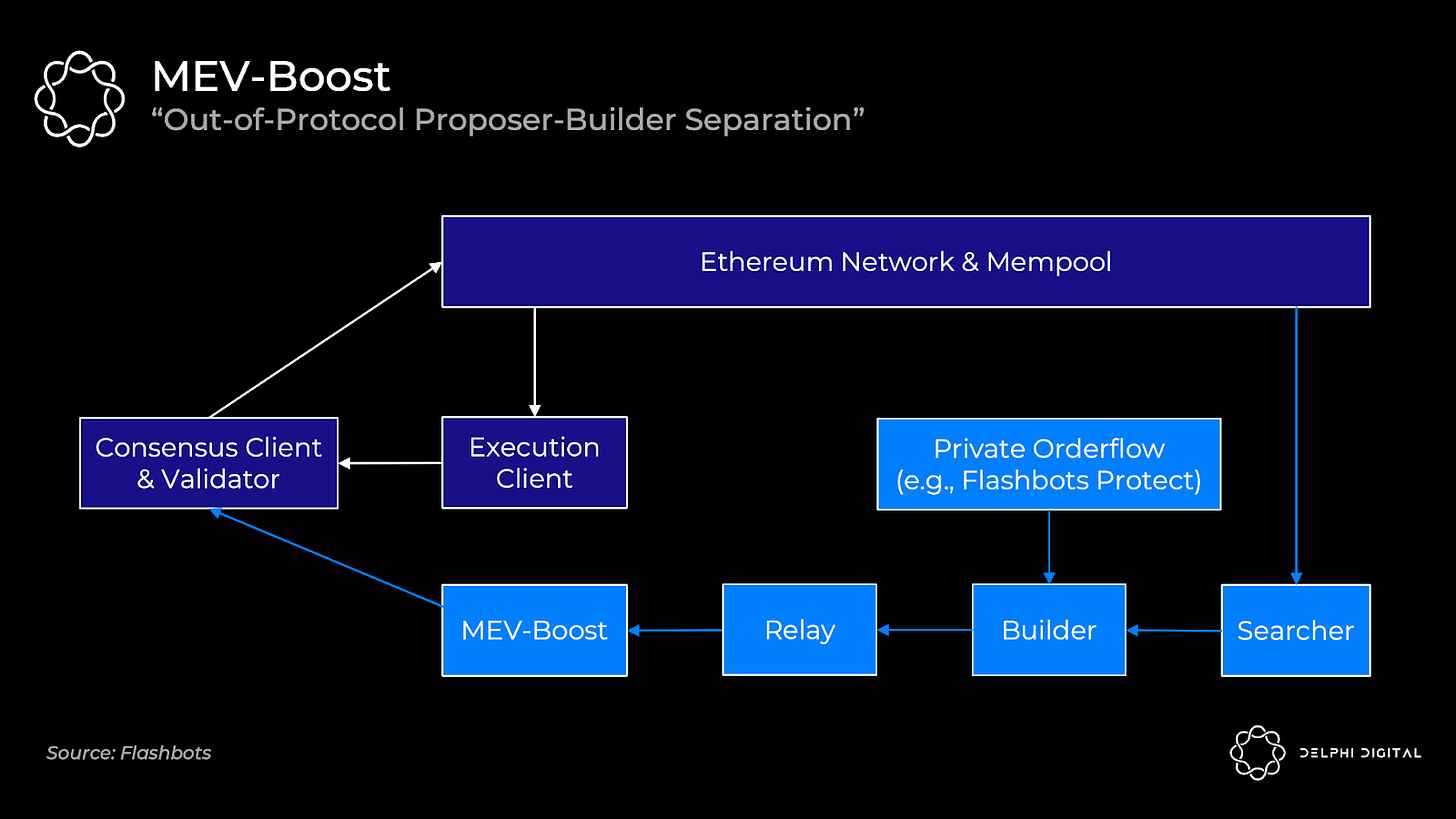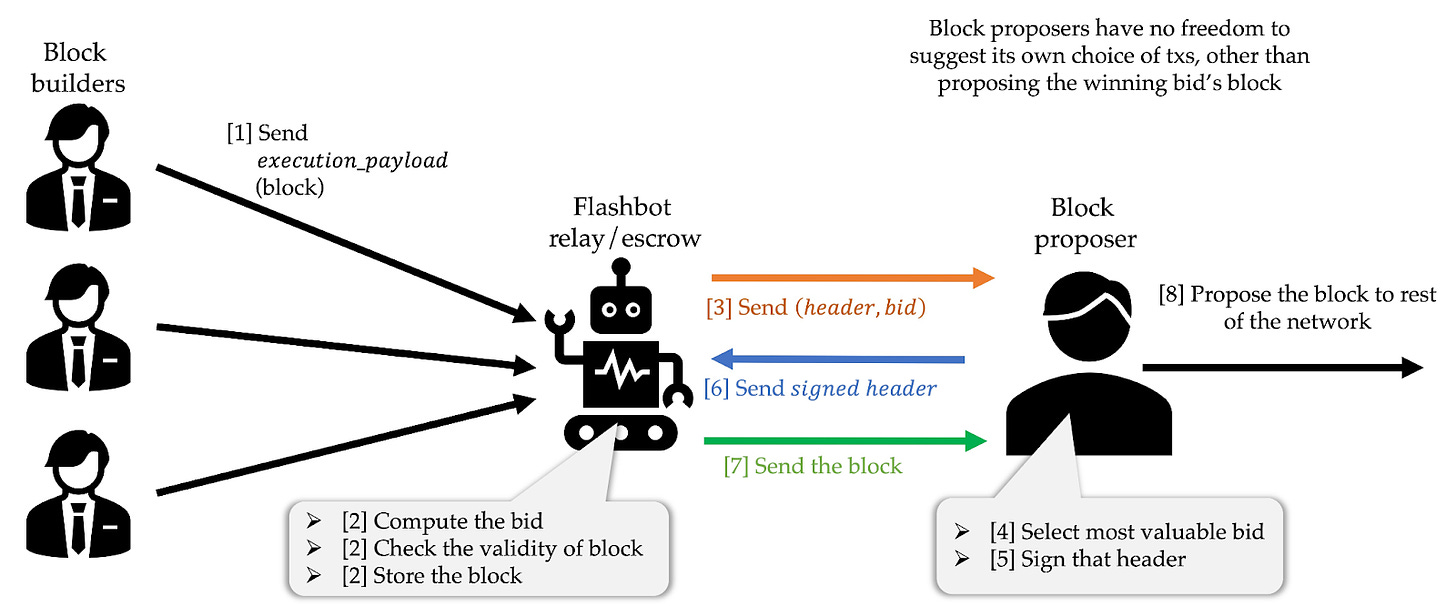Introduction
The block relayers of Flashbots continue to dominate the ecosystem of Ethereum validators. Consequently, censorship continues to expand. Censorship is incompatible with Ethereum’s values.
Flashbots, BloXroute, and Blocknative account for the vast bulk of MEV-Boost relays. As of this writing, around 84% of the MEV-Boost blocks that have been transmitted have been submitted by Flashbots.
Despite pressure from Ethereum developers and experts who consider the action as detrimental for the platform, the Flashbots team has been largely silent on the matter of censorship. Robert Miller, the product lead for Flashbots, answered the public outrage against censorship on September 29 via a tweet: "I hear you and appreciate the criticism."
MEV-Boost
Maximal (miner) extractable value (MEV) is the revenue that block builders and validators receive for inserting or reordering transactions within a block. Researchers of MEV have attempted to resolve the flaws that have made it an unanticipated channel for user exploitation, centralization, and (now) censorship.
MEV detection demands expertise. If validators are assigned this responsibility, they will centralise; only skilled validators capable of extracting MEV will earn higher returns. This is addressed by Proposer-Builder Separation (PBS) by creating a new specialised "builder" role to construct the ideal block. The builder then submits an acceptance bid to the proposer (validator). As long as proposers continue to receive competitive returns, the system will stay decentralised.
PBS will be incorporated into the protocol eventually, although it is not yet ready. However, PBS is here - MEV-Boost is the non-protocol major step for now. It is supplementary software that validators can utilise to search for outsourced block creation. Validators retain the option to utilise their own execution client and local build blocks. The image depicts Vitalik's explanation of the term MEV-Boost.

Many MEV searchers employ specialised tactics and bid on builders to include their transaction packages in their transaction packages. Builders can use these bundles with any additional private orderflow and public mempool transactions to construct the optimum full block. Some builders can also do their own internal searches and fulfil this function.

Relays are trusted mediators between proposers and builders. They receive building blocks and place them in escrow prior to delivering them to the proposer. For a particular relay, the procedure can take the following form:

It is essential to understand the type of Ethereum's equirement MEV-Boost solves. This is why we are currently discussing a censorship-level threat.
1. Solo-staker participation
PoW miners were issued bundles, which they would then use to construct the whole block. They never received complete blocks. Flashbots never included OFAC-blocked transactions in their bundles, but it won't affect because miners could just insert them elsewhere in the block.
This approach necessitated putting faith in the mining pool operators; they could see the clear packages, thus they could easily appropriate such possibilities for themselves. This trust is not scalable to a large collection of Ethereum validators. Consequently, MEV-Boost delivers entire blocks to proposers. Proposers sign and commit to the block header prior to discovering the block content. If they attempt to MEV-steal after viewing the block's body, they must then suggest an alternative block. Their original signature may be exhibited; for double-signing, proposer is slashed.
This full-block protocol promotes decentralisation of validators, but introduces a substantial censorship risk at the relay/builder level. Validators will be de facto censors if they approve blocks from censoring relays. If a censoring developer is the most profitable developer, the proposer must select between:
-
Economically rational - accepting the block with the highest value, even if it is censored
-
Altruistic - accepting a block with a lower value that does not censor
2. Client diversity
The majority of miners were utilising the Go Ethereum (Geth) client, so Flashbots simply created MEV-Geth by forking it. The only way to engage in the Flashbots Auction was to execute it. Point-of-sale was a chance to increase client diversity. The sidecar for MEV-Boost is compatible with all consensus and execution clients.
MEV-Boost is neutral infrastructure:
-
Relays: Free to be run with any restrictions or strategies the participants desire (e.g., censoring/non-censoring, "fair" ordering/max-profit, etc.). As desired, relays can accept blocks from builders.
-
Builders: Free to run whatever approaches they desire and deploy their blocks to any trusted relay that is ready to accept them.
-
Validators: Free to use MEV-Boost whether or not you want to. Free to use with any clients they choose. They are permitted to link to as many or as few relays as they choose. MEV-Boost is essentially a relay aggregator that selects the most profitable bid among the relays chosen by the proposer.
This is how I’ll frame the censorship discussion:
-
Weak censorship: postponed, but eventual incorporation If, for example, 50% of validators do not include OFAC transactions, they will be added on average after two blocks (24 seconds). If 90% of individuals censor, they will be admitted after 10 blocks (120 seconds).
-
Strong censorship: censored transactions are not added to the blockchain. In Gasper, this necessitates that 51% of validators (simplification, proposer boost can alter the arithmetic) not only censor OFAC transactions for their own blocks, but also actively disregard all new blocks that incorporate them.
Validators do not appear to pose an imminent threat of censorship. They have apparently adopted the position that they are not required to censor OFAC transactions. This could be handled by a user-activated soft fork or by slicing if necessary, but that is not my major concern here.
The imminent threat of censorship is at the relay or builder level. Primarily from Flashbots, which operates the largest relay and constructors. However, other relays also censor; they simply have a smaller market share, including:
-
bloxRoute’s “Regulated” relay
-
Blocknative
-
Eden Network
Non-censoring relays:
-
bloxRoute’s “Max-profit” relay
-
bloxRoute’s “Ethical” relay
-
Manifold Finance
Last week, Flashbots co-founder Stephane Gosselin revealed on Twitter that he had resigned from the Flashbots due to disagreements with team over censorship.
Final Thoughts
I relied heavily on Flashbots for a variety of reasons. Obviously, they are the main cause of censorship, but they've also been the source of a tremendous amount of increased efforts for the Ethereum ecosystem. In addition, I believe they have a substantial obligation to the ecosystem if they are to walk the line between neutral community builder and conventional corporate operator. Lastly, because they are intelligent and can likely create wonderful things.
However, I also strongly implore other relays and builders to operate in a good-faith manner and support the ecosystem as much as possible through similar actions. Ethereum and crypto as a whole may have a limited window to get this right.